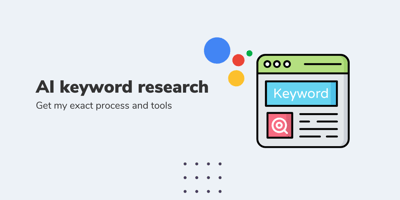Creating SEO-optimized content is essential for online visibility, and with AI, you can streamline...
Leveraging AI and RPA to Optimize Poor-Performing Metadata Descriptions
In today's digital marketing landscape, metadata descriptions are crucial for content performance. Well-crafted metadata is indispensable for driving SEO rankings, enhancing click-through rates (CTR), and ensuring content visibility. However, many digital content marketers struggle with poor-performing metadata descriptions that undermine content discoverability and engagement
Artificial Intelligence (AI) and Robotic Process Automation (RPA) offer a scalable and efficient solution to optimize metadata at scale. Let's explore a structured approach for leveraging these technologies to transform underperforming metadata into a strategic advantage.
Understanding the Metadata Problem
Before diving into solutions, it's essential to recognize why metadata underperforms:
- Generic Content: Lack of uniqueness or relevance to user intent
- Manual Workloads: Time-consuming process of reviewing and updating metadata for numerous assets
- Inconsistent Guidelines: Varying metadata standards across platforms
- Keyword Mismatch: Failure to align descriptions with trending search queries
Traditional manual approaches are not scalable for modern digital marketing, where large content repositories require constant optimization
Role of AI in Metadata Optimization
AI technologies, particularly those leveraging Natural Language Processing (NLP) and Machine Learning (ML), bring significant advancements to metadata optimization. Here’s how AI can help:
a. Automated Analysis and Evaluation
AI tools can quickly analyze thousands of metadata descriptions to identify underperforming areas. Metrics like CTR, bounce rates, and keyword relevance can be assessed to pinpoint gaps.
- Example: Using AI-powered tools such as SEMrush or BrightEdge, marketers can analyze metadata against top-performing content.
b. Content Optimization with NLP
NLP algorithms enable AI to generate and refine metadata descriptions that are both SEO-friendly and tailored to audience intent. AI models can:
- Extract relevant keywords from the content.
- Create concise, engaging, and unique descriptions.
- Align metadata with high-performing search trends.
Practical Implementation:
Platforms like ChatGPT or other AI models can automate the rewriting of metadata descriptions. For instance:
- Old Metadata: “Learn about digital marketing tips.”
- AI-Generated: “Discover actionable digital marketing strategies to boost ROI and brand visibility in 2024.”
c. Predictive Performance Insights
AI doesn’t just optimize—it predicts. By analyzing metadata against search trends and user behavior, AI tools provide forecasts on CTR improvements and SEO rankings. This enables marketers to prioritize changes with the greatest impact.
How RPA Complements AI for Scale and Efficiency
While AI focuses on enhancing the quality of metadata, Robotic Process Automation (RPA) handles the execution and scalability of updates. RPA automates repetitive tasks, reducing human effort and errors. Here’s how RPA can assist:
a. Bulk Processing of Metadata Updates
Manually uploading optimized metadata across multiple platforms (CMS, e-commerce, or databases) is tedious. RPA bots can automate this process:
- Extract metadata from content repositories.
- Replace poor-performing descriptions with AI-optimized versions.
- Update fields in bulk across platforms like WordPress, HubSpot, or SharePoint.
b. Workflow Automation
RPA can seamlessly integrate with existing systems to streamline metadata workflows:
- Pulling data for analysis.
- Coordinating AI-generated content updates.
- Scheduling regular metadata audits.
For example, an RPA bot can schedule weekly metadata checks, trigger AI tools for optimization, and update platforms without human intervention.
c. Consistency Enforcement
RPA bots ensure consistency across platforms by adhering to predefined metadata guidelines. This helps maintain brand voice, tone, and SEO strategies across all content assets.
Structured Approach for Marketers
To successfully utilize AI and RPA for optimizing poor-performing metadata, digital content marketers can follow this structured approach:
Step 1: Audit Your Metadata
- Use AI tools to analyze metadata across your content repository. Identify underperforming descriptions by evaluating metrics such as CTR, bounce rate, and ranking position.
Step 2: Define Metadata Optimization Guidelines
- Set clear rules for metadata (e.g., word count, tone, target keywords). AI tools can reference these guidelines when generating new descriptions.
Step 3: Implement AI for Optimization
- Use AI-driven platforms to rewrite and optimize metadata. Ensure alignment with target keywords, trending search queries, and user intent.
Step 4: Automate Updates with RPA
- Deploy RPA bots to upload AI-optimized metadata across platforms. Schedule recurring updates to ensure metadata remains relevant.
Step 5: Monitor and Refine
- Track the performance of updated metadata using analytics tools. Use AI insights to make continuous improvements.
Tools and Technologies for AI and RPA
Here are some recommended tools for implementing AI and RPA:
- AI Tools: ChatGPT, MarketMuse, BrightEdge, SEMrush, Surfer SEO.
- RPA Platforms: UiPath, Automation Anywhere, Blue Prism.
- Integration Platforms: Zapier, Power Automate (to connect systems and workflows).
For smaller teams, integrating affordable AI tools like ChatGPT with lightweight automation tools can still yield significant results.
Benefits of Combining AI and RPA
By leveraging AI and RPA, digital content marketers can achieve the following:
- Efficiency: Reduce manual effort and optimize thousands of descriptions quickly.
- Improved Performance: Enhance search rankings, CTRs, and audience engagement.
- Scalability: Maintain high-quality metadata across large content libraries.
- Consistency: Enforce uniform metadata standards and branding.
- Data-Driven Optimization: Use AI insights to continuously refine strategies.
Overcoming Challenges
While AI and RPA offer immense value, implementation challenges include:
- Tool Integration: Ensuring seamless integration between AI, RPA, and existing systems.
- Data Quality: Poor-quality content can limit AI’s optimization capabilities.
- Change Management: Upskilling teams to leverage AI and RPA effectively.
To overcome these, marketers should start small with pilot projects, measure impact, and scale gradually.
Conclusion
Poor-performing metadata can hinder content visibility, but with AI and RPA, digital marketers can efficiently optimize metadata at scale. AI brings intelligence and creativity to content optimization, while RPA ensures seamless execution. By combining these technologies, marketers can enhance performance, save time, and stay ahead in an increasingly competitive digital landscape.
For digital marketers ready to transform their metadata strategy, now is the time to embrace AI and automation—not just as tools but as essential components of modern content optimization.





